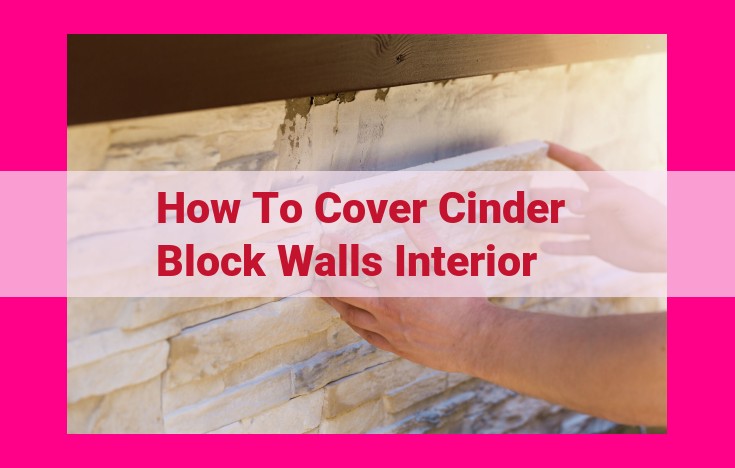Diy Guide: Cover Cinder Block Walls With Drywall For A Seamless Interior

To cover cinder block walls interiors, a popular method is dry-walling. It involves attaching vertical furring strips to the block wall first, and then securing drywall panels over the strips using screws or nails. Alternatively, you can use adhesive to fix the drywall directly to the cinder block wall. Once installed, apply joint tape and compound over the joints, and sand smooth. Finally, apply primer and paint for a finished look.
Materials for Interior Wall Construction: A Comprehensive Guide
When it comes to interior wall construction, choosing the right materials is crucial. Each material offers unique properties, advantages, and drawbacks. This guide will delve into the diverse materials used for interior walls, helping you make informed decisions for your project.
Cinder Blocks: Durable and Soundproof
Cinder blocks, renowned for their durability and soundproofing abilities, are commonly used in basements, garages, and workshops. Composed of a mixture of concrete, cinders, and fly ash, they boast excellent fire resistance and can withstand significant weight. However, they require professional installation and can be difficult to modify.
Drywall: Versatile and Affordable
Drywall, also known as gypsum board, is the most versatile and economical choice for interior walls. Made of plaster encased in paper, it is lightweight, easy to install, and can be painted or textured to suit any design style. Its fire resistance and acoustic properties make it suitable for various applications. However, it can be susceptible to moisture and damage if not properly installed.
Paneling: Aesthetic Appeal and Warmth
Paneling, available in a wide range of materials such as wood, composite, or PVC, offers aesthetic appeal, durability, and warmth. Its natural textures and grain patterns add character to any room. Paneling is easy to install, resistant to moisture, and can be painted or stained to match the decor. However, it may be more expensive than other materials.
Wallpaper: Style and Expression
Wallpaper provides endless design possibilities, transforming walls into artistic masterpieces. It can conceal imperfections, add texture, and create a unique ambiance. While some wallpapers are easy to remove, others require professional installation. It is important to choose a wallpaper that is appropriate for the environment and cleaning needs.
Paint: Color and Protection
Paint remains a popular and affordable option for interior walls. It comes in a vast array of colors and finishes, allowing for customization and the creation of different moods. Paint protects walls from damage and can be easily cleaned. However, it may require multiple coats for optimal coverage.
Tools and Equipment for Interior Wall Construction
Every home improvement project requires the right tools and equipment to ensure success. Interior wall construction is no exception. Before you dive into your project, gather the essential tools and materials that will empower you to create professional-looking results.
Measuring and Marking Tools
Every project begins with accurate measurements. A measuring tape is indispensable for determining wall dimensions, stud spacing, and other critical measurements. A level ensures that walls are plumb and free of unsightly tilts. A stud finder helps you locate studs behind drywall, allowing you to anchor your wall securely.
Cutting Tools
For precise and efficient wall construction, an array of cutting tools is essential. A drywall saw swiftly slices through drywall, while a drill creates holes for screws and studs. And don’t forget screws and nails, the fasteners that hold your wall together.
Finishing Tools
Once the wall structure is complete, it’s time to add the finishing touches. A paintbrush and roller will paint the wall to your desired color. Furring strips create a level surface for drywall and paneling installation. And drywall adhesive secures drywall to walls and ceilings.
Safety Gear
Safety should always be paramount when working on any home improvement project. Wear safety glasses to protect your eyes from flying debris. Gloves prevent cuts and abrasions when handling sharp tools. And a dust mask helps you breathe easy in dusty environments.
By assembling these essential tools and equipment, you’re fully prepared to embark on your interior wall construction project with confidence. Remember, the right tools can make all the difference in achieving a professional-looking and durable result.
Interior Wall Construction: Techniques to Enhance Your Space
Building Codes and Regulations: The Guiding Lights
When embarking on interior wall construction, it’s crucial to adhere to established building codes and regulations. These guidelines ensure structural integrity, safety, and compliance with industry standards. Failure to comply can lead to costly fines or even endanger the occupants.
Insulation and Vapor Barriers: Protecting Your Interior
Interior walls play a vital role in regulating temperature and humidity. Insulation barriers prevent heat transfer, creating a comfortable living environment. Vapor barriers prevent moisture from penetrating walls, protecting against mold and mildew growth.
Texture Options: Adding Character and Style
The texture of your interior walls can significantly impact the overall ambiance of your space. Smooth walls offer a sleek, modern look, while textured walls add visual interest and character. Consider options like _knockdown, popcorn, or** stipple finishes**.
Color Schemes: Reflecting Your Personality
Color plays a pivotal role in shaping the mood and atmosphere of a room. Light colors create a sense of space and tranquility, while dark colors evoke intimacy and sophistication. Experiment with analogous, complementary, or monochromatic color schemes to create a cohesive look.
Interior Decorating Styles: Expressing Yourself
Interior wall construction provides a blank canvas for expressing your unique style. Consider popular design aesthetics like _modern, rustic, minimalist, coastal, or traditional. Each style offers a distinctive blend of colors, textures, and furnishings.
Professional-Looking Results: Tips and Best Practices
To achieve a professional-looking finish, follow these tips:
- Use high-quality materials and tools.
- Measure and plan carefully before cutting or installing.
- Apply materials evenly and smoothly.
- Pay attention to details like corners, seams, and edges.
- Consult with an expert if necessary.
By embracing these techniques and best practices, you can turn your interior wall construction project into a stunning masterpiece that will enhance the beauty, comfort, and value of your living space.